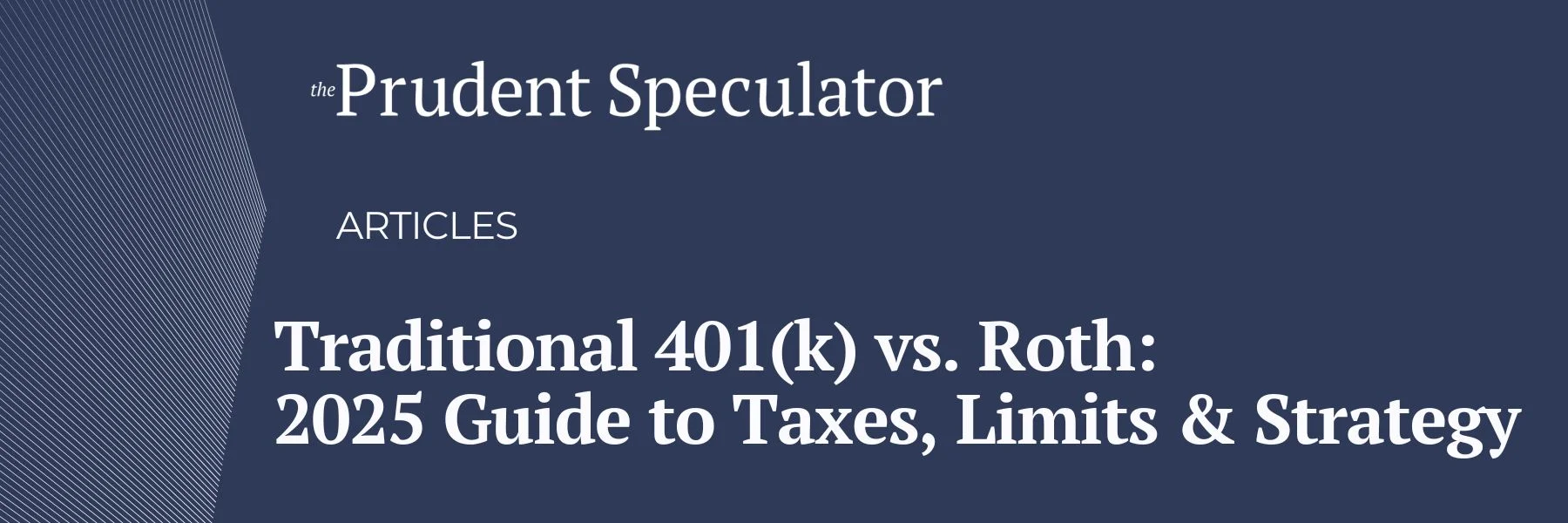As part of our ongoing commitment to helping you navigate financial changes with confidence, we’re sharing a concise summary of the recently passed One Big Beautiful Bill Act.

A Prudent Investor’s Guide to the One Big Beautiful Bill
As part of our ongoing commitment to helping you navigate financial changes with confidence, we’re sharing a concise summary of the recently passed One Big Beautiful Bill Act. This new legislation brings a mix of continuity, notable changes and entirely new tax planning opportunities.
What Holds Steady in the One Big Beautiful Bill
- Tax brackets remain at 10%, 12%, 22%, 24%, 32%, 35% and 37%. Inflation adjustments in 2026 will slightly narrow the 22% band.
- The Standard Deduction rises modestly in 2025. Married filing jointly increases to $31,500.
- Filing thresholds remain indexed to inflation.
- Itemized deductions continue with current limits. The mortgage interest cap remains in place and the repeals of moving expenses, personal exemptions and miscellaneous items remain in force.
- Mortgage insurance premiums qualify as deductible residence interest.
- The Child Tax Credit increases on the non-refundable side to $2,200 in 2026, and the $1,700 refundable portion in 2025 becomes permanent and indexed to inflation.
- The QBI deduction continues with higher income phaseouts. The phaseouts are $150,000 for joint filers and $75,000 for other filers.
- Student loans that are discharged due to death or disability remain nontaxable and employers may continue to provide tax-free repayment assistance.
- ABLE accounts, education assistance and dependent care benefits retain their existing rules.
- Cash contribution limits, HSA rules and PTETs do not change.
- Combat zone benefits continue to apply.
What Changes in a Meaningful Way
- The State and Local Tax (SALT) deduction increases to $40,000 and it increases to $20,000 for married filing separately. The deduction phases out starting at $500,000 of income and at $250,000 for married filing separately.
- The (Alternative Minimum Tax) AMT may affect more filers in 2026 because thresholds revert to 2018 levels and the prior seven years of inflation adjustments are removed for joint filers.
- The Itemized Deduction Limitation (Pease limitation) on itemized deductions returns for taxpayers in the 37% bracket after 2025.
- The adoption credit becomes refundable up to $5,000 beginning in 2025.
- Green energy credits remain available through 2025 with phased expiration schedules, and it then terminates. The affected credits include clean vehicle, previously owned clean vehicles, commercial clean vehicle, alternative fuel refueling property, residential clean energy, energy efficient home improvement and new energy efficient home.
- Qualified Opportunity Zones add new five-year basis tiers. Regular zones provide a ten percent step up and rural funds provide a thirty percent step up.
- Bonus depreciation and Section 179 receive higher limits, and 100% expensing returns for qualified property placed in service after January 20, 2025.
- Qualified Depreciation and Section 179 Expensing (QSBS) introduces tiered gain exclusions based on holding period with higher per issuer caps and asset thresholds.
- Interest on rural or agricultural loans may be excluded for qualified lenders.
What Is New in the One Big Beautiful Bill
- The senior deduction provides an additional $6,000 per qualifying person age 65 or older and it phases out at higher incomes. The provision applies from 2025 through 2028.
- The no tax on tips deduction allows a deduction up to $25,000 with income based phaseouts and anti-abuse rules, and payroll taxes still apply.
- The overtime deduction allows a similar $25,000 limit with phaseouts at $300,000 for joint filers and $150,000 for other filers.
- Car loan interest becomes deductible up to $10,000 for loans on new cars assembled in the United States, subject to strict income and loan limitations. Leases do not qualify.
- A charitable deduction for non-itemizers becomes available up to $2,000 for married couples who give cash beginning in 2026.
- A new cap limits itemized deductions to 35% of AGI beginning in 2026.
- A new AGI floor requires charitable gifts to exceed 0.5% of AGI beginning in 2026.
- Trump Accounts introduce child-focused savings that follow IRA style rules with strict contribution and investment limits. The accounts apply to dependents under age 18. Employers may contribute, Treasury will run a pilot and children born from 2025 to 2028 receive a $1,000 seed.
Other Notable Changes
- The estate tax exemption rises to $15 million per person in 2026 with portability and inflation indexing in the One Big Beautiful Bill.
- Medicaid adopts new work and residency requirements with significant funding cuts beginning in 2026.
- Section 529 plans expand to a broader set of qualified K-12 expenses and the annual limit doubles to $20,000.
- Student loan strategies remain centered on IBR and PSLF, and PAYE may sunset after 2026, so borrowers should revisit their repayment choices.
- Educator expenses for unreimbursed classroom costs return as miscellaneous itemized deductions.
- Social Security taxation does not change and benefits remain taxable up to 85%. No exclusion or credit appears in the final bill.
Let’s Have A Conversation
We believe true wealth management goes beyond numbers. It’s built on trust, transparency and a deep understanding of your goals. As fiduciaries, we’re committed to putting your best interests first, always.
Whether you’re navigating life transitions, planning for future generations or seeking a partner to help you make confident financial decisions, we’re here to help.
To learn more about our personalized wealth and asset management services, please see our Wealth Management page or reach out to Jason Clark, CFA at jclark@kovitz.com.
Sources: Congress.gov. IRS.gov.
Kovitz Investment Group Partners, LLC (Kovitz) is an investment adviser registered with the Securities and Exchange Commission under the Investment Advisers Act of 1940 that provides investment management services to individual and institutional clients. From October 1, 2003, to December 31, 2015, the Firm was defined as Kovitz Investment Group, LLC. Effective January 1, 2016, Kovitz Investment Group, LLC under went an organizational change and all persons responsible for portfolio management became employees of Kovitz. From January 1, 1997, to September 30, 2003, all persons responsible for portfolio management comprised the Kovitz Group, an independent division of Rothschild Investment Corp (Rothschild).
This article is for informational purposes only. The content and One Big Beautiful Bill discussion does not present a complete picture of the new tax and spending legislation, but Kovitz believes the information is representative of some issues and changes relevant to our clients. This should not be construed as specific investment, tax, or legal advice. Individuals should seek advice from their wealth advisor or other advisors before undertaking actions in response to the matters discussed. No client or prospective should assume the above information serves as the receipt of, or substitute for, personalized individual advice.
This represents the opinions of Kovitz, may contain forward-looking statements, and presents information that may change due to market conditions or other factors. Nothing contained in this presentation may be relied upon as a guarantee, promise, assurance, or representation as to the future. Investing involves risk, including, but not limited to, loss of principal. All tax laws and regulations discussed are subject to change. This is prepared using third party sources considered to be reliable; however, accuracy or completeness cannot be guaranteed. The information provided will not be updated any time after the date of publication. Numerous representatives of Kovitz may provide investment philosophies, strategies, or market opinions that vary. The appropriateness of a particular investment or strategy will depend on an investor’s individual circumstances and objectives.
The description of products, services, and performance results of Kovitz contained herein is not an offering or a solicitation of any kind. Past performance is not an indication of future results. Securities investments are subject to risk and may lose value.




